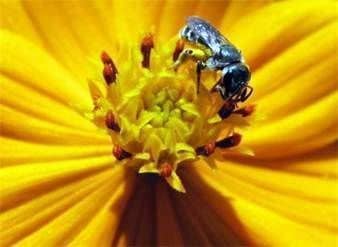
Many will be surprised that the formation of a family in a bee family is by no means the rule, but rather an exception. We know many thousands of species of bees, who spend their entire lives alone. Some of them are very similar in appearance to honey bees, others are even larger and stronger than them, and others are so small and thin that the layman can take them for winged ants. They all build cells, collect honey and pollen for their babies, but each female works only for herself, alone, without the support of “worker bees.” Each of these creatures is subject to the special laws of care for the offspring prescribed to him by nature. Often they are so peculiar that the description of the way of life of single bees can be attributed to the most fascinating chapters of biology of insects.
For example, there is a bee that arranges its nest in the passages gnawed in the wood. At the end of the corridor, she brings flower pollen and nectar, prepares a honey dough from them and lays an egg on it. At some distance from the egg, so that there is enough room for the growing larva, it erects a transverse bulkhead from the resin.
The second, third and fourth are attached to the first chamber; each of them is supplied with honey test, egg and protective wall of resin.

Fig. 105. The nest of a single bee just completed. The oldest larva in the dead end of the corridor has already eaten almost the entire stock of feed, it is finishing growth. In younger cells, larvae of correspondingly smaller size. Each chamber for the larva is equipped with a honey test and is separated from the adjacent resin partition. The mother is visible at the entrance (full size).
Finally, the bee stains the entrance hole with resin and no longer cares about its offspring. Each larva hatched from the egg finds as much food as it needs for its full development. Then she pupates in her house of wood and resin, and turned into an adult bee, gnawing his way to freedom. The males and females leaving the cells mate in the air. Males soon die, and inseminated females, obeying instinct, build a cradle for their children, as did their mother. They could not see her for this work and would never see their own children.
Темные соты что это. Дрожжевая паста.
Breeds of bees